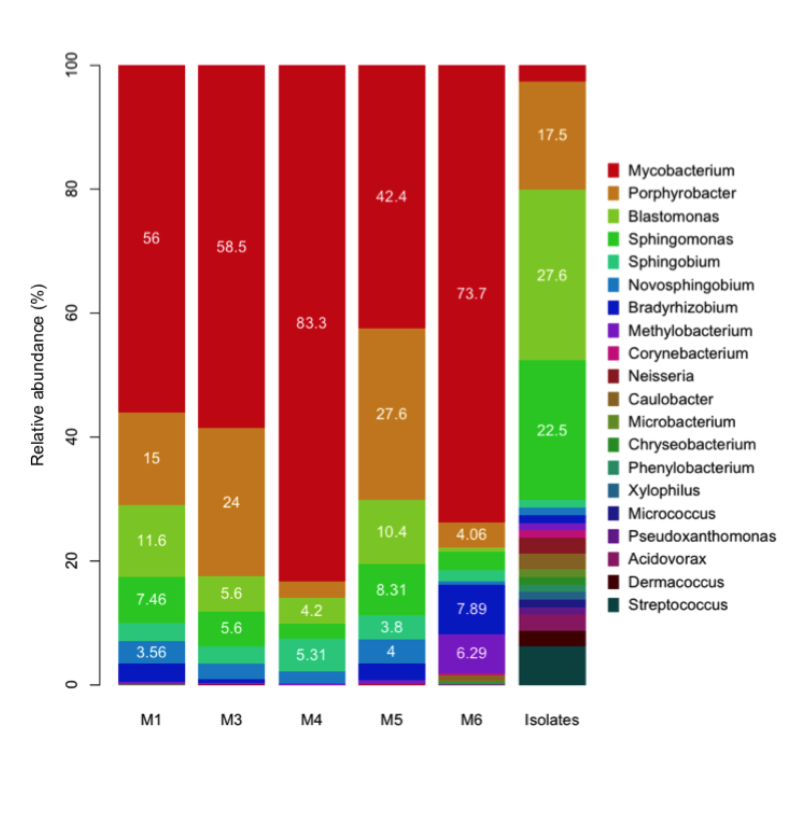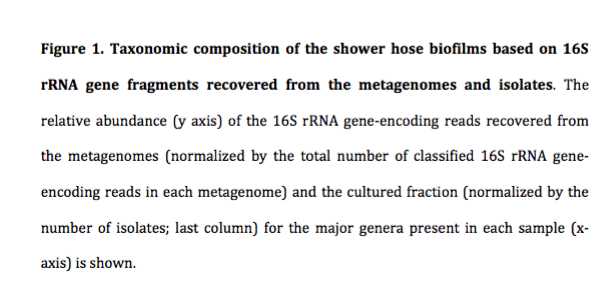There is a new paper in AEM of interest: Characterization of biofilms developing on hospital shower hoses and implications for nosocomial infections by Maria J. Soto-Giron, Luis M. Rodriguez, Chengwei Luob, Michael Elkd, Hodon Ryu, Jill Hoelle, Jorge W. Santo Domingo and Konstantinos T. Konstantinidis
They used 16S rRNA gene sequencing of cultured isolates, and metagenomic sequencing, to characterize the microbes living in hospital shower hoses.
They report in the abstract:
The resulting data revealed a Mycobacterium-like population, closely related to M. rhodesiae and M. tusciae, to be the predominant taxon in all five samples, and its nearly complete draft genome was recovered. In contrast, the fraction recovered by culture was mostly affiliated to Proteobacteria, such as members of the genera Sphingomonas, Blastomonas, and Porphyrobacter. The biofilm community harbored genes related to disinfectant tolerance (2.34% of the total annotated proteins), and a lower abundance of virulence determinants related to colonization and evasion of the host immune system. Additionally, genes potentially conferring resistance to beta-lactam, aminoglycoside, amphenicol, and quinolone antibiotics were detected. Collectively, our results underscore the need to understand the microbiome of DW biofilms using metagenomic approaches. This information could lead to more robust management practices that minimize risks associated with exposure to opportunistic pathogens in hospitals.
A summary of what they did is below:
- Collected samples from biofilms in hoses in 2012 from 40 showerheads in a hospital in Ohio
- Cultures were grown from a sample of these biofilms and some of the isolates were typed using rRNA gene sequencing. A subset of these had their genomes sequenced.
- Metagenomic sequencing was done from give samples
- Taxa, genomes and metagenomics were analyzed
Results and Discussion
- A large fraction of the metagenomic reads that could be taxonomically assigned were assigned to Actinobacteria closely related to the genus Mycobacteria.
- They predict that potential opportunistic pathogens were present
- Many of the organisms in the sample appear to carry antibiotic resistance genes
- They compare their data to that from other “similar environments” including pipes and ICU surfaces. Though I don’t understand why they did not compare their data to that from Feazel et al. (Shower biofilms). Definitely something to follow up on. I will try to ask the authors for an explanation.
- They analyze the genomes and metagenomes to try and get more detail on the strains present in the samples
- They discuss what they see as implications for nosocomial infections
Here is the figure on taxonomic composition of their samples
Anyway – the paper may be of interest to those out there looking at the microbiology of water systems in the built environment. I think the paper should be viewed as very preliminary and they do not have any information about health risks or even correlations to health risks, but the data may be useful for designing or interpreting future such studies.


Some responses from Twitter:
I am the founder and owner of High Sierra Showerheads. I have always believed that our shower heads are less likely to harbor and promote the growth of bacteria than conventional shower heads because they fully drain after each use, use a single nozzle to create the spray for showering, and the internal parts are all metal except for the silicone flow control diaphragm. Unfortunately I have no evidence to support this theory. I would be very interested in supplying sample shower heads for testing by researchers.
Thanks David. I will share this with various people working on the topic.
Thanks so much, Jonathan!
To riff a bit on what David Malcolm said here, and on behalf of any researchers who might wish to explore this further, High Sierra’s showerheads, which have been on the market only since 2009:
* Are based on a spray nozzle for a handheld golf greens sprayer.
* Make their spray by water into two streams, via a pin, and slamming them back together.
* Have a very large, single exit opening (orifice). The internal flow regulator diaphragm that David mentioned, above, also has a large opening. And the water path from shower arm to exit opening is straight through, without obstacles. Collectively, this means that there are few, if any, places where minerals like calcium or magnesium can build up to obstruct flow, or where fine particles of sand or grit in the water might get lodged.
* In contrast, conventionally-designed showerheads have small exit holes, which almost inevitably clog over time. (Fun fact: the ‘drop water through small holes in a perforated disc’ design that’s used by nearly all of the world’s showerheads today dates back to at least the 1850s, according to historical photos and descriptions from that era.) And most showerheads today include an internal flow regulator whose design typically combines an o-ring with a plastic disc, the latter also containing very small holes, thus presenting another location that is subject to clogging. Both of these are points where water might remain in the showerhead, even after the shower water is turned off. And each of these also might be places where microbes could build up.
* Some conventional showerheads contain internal apparatus, such as turbines to pulse water, which could potentially serve as obstacles, preventing water from fully draining after shutoff.
* Some conventional showerheads also aerate the water, by creating turbulence within the water stream, or by using a Venturi tube. Where these techniques draw bathroom air into the showerhead, that may be another potential source for introducing microbes into the water stream.
While this is supposition, as a result of the design differences described above, there is some basis to believe that High Sierra’s design *might* be less hospitable to microbial buildup – including the hosting of pathogens – than conventional showerhead designs. It’d be terrific to have that prospect investigated.
A correction to add an inadvertently omitted word in the above comment:
“* Make their spray by *splitting* water into two streams, via a pin …”
And for the sake of accuracy, at the risk of garrulousness … to be fair to conventional showerhead designs, many of these now have small nozzle nubs of silicone or a similar flexible polymer. As a result, it’s become easier to dislodge the buildup of mineral scale by rubbing these back and forth, rather than by having to soak the entire showerhead in vinegar.
That’s assuming that institutional or residential consumers are diligent about doing such maintenance cleaning, of course. And that design improvement doesn’t address the parallel buildup of scale or grit inside the showerhead, on a flow regulator disc or other internal apparatus.
Also, none of what I’ve (or David has) written about here addresses the issue of biofilms in handheld showerhead hoses, which I understand was at issue in the new AEM paper. The showerheads whose designs were compared, in a previous comment, were ‘fixed’ models that don’t include such hoses.
Hi Aron,
I’m the first author of this paper. We are very interested in sampling more showerhead hoses and compare the biofilm microbial community among showerhead hoses made from different materials/compounds. With this AEM paper, we understood the importance of these devices as reservoirs for potential nosocomial pathogens. We can chat a little bit more about it. Let me know
Made a storify of additional responses on Twitter including some discussion of extraction method and new sequencing technologies.
Hi Jonathan,
this is Juliana, the first author of this paper. Thanks for making this short presentation with tweets about this interesting topic. We definitely want to continue applying metagenomics in the built environment, mainly in the hospital environment in order to evaluate ecological interactions of microbial members with a potential pathogenic/resistance profile associated with the increase of nosocomial infections
Juliana – would you have any interest in writing more about this paper or related work here? Let me know …
yes, I’m interested
awesome — will send you an email to discuss
perfect! looking forward to it